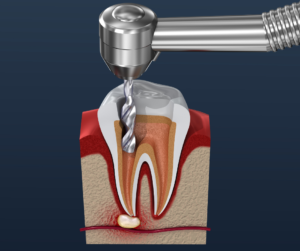Our teeth are susceptible to issues such as poor oral hygiene, infection, and decay. Unfortunately, these problems can lead to discomfort and pain and can also detract from the person’s smile and overall appearance – not to mention their self-confidence. Because of anxiety about going to the dentist, many people endure problems with their teeth without seeking treatment. However, there are simple solutions to most dental issues involving pulp of the tooth, and when it comes to tooth decay, these solutions often include a choice between root canal treatment and tooth extraction. Let’s take a closer look at these two options and how to know which one is right for you.
Root Canal

A root canal is often the best choice. These procedures have a very low risk of complications, particularly when performed by an endodontist (a dental specialist who focuses on saving natural teeth). The purpose of a root canal is to clean and restore an infected tooth. When you choose to have a root canal, there is no need to remove the tooth. The endodontist removes the infected or inflamed pulp, cleans the root canal, and then fills and seals off space. Later, you will receive a crown on the tooth to keep it protected and restore its full function by the general dentist.
Some people are afraid that their root canal will be painful, but that isn’t the case. We keep our patients as comfortable as possible; in fact, they are often able to return to work the same day. Risks include the possibility of damage to the tooth enamel or infected material being left behind to continue to spread. However, these risks are minimal and made even smaller by having an endodontist perform your procedure. A root canal aftercare is very simple and involves only avoiding eating until your mouth is no longer numb and taking over-the-counter pain medication if needed and following further instructions provided by your endodontist.
Tooth Extraction

While extraction may seem like the simplest treatment when dealing with an infected tooth, this procedure can indeed be quite complicated in some cases. Even so, extraction is recommended in some instances, such as when removing a tooth is necessary to keep your mouth and your remaining teeth healthy. During a tooth extraction, you’ll receive anesthesia to numb the area so that you won’t feel any pain during the procedure. However, you might experience pain after the numbness wears off; over-the-counter pain medications are usually sufficient to relieve this pain.
A missing tooth can also potentially cause problems for the neighboring teeth. Because they aren’t receiving any physical support, they may shift in the mouth, causing problems such as overlapping, crowding, or misalignment. However, you can mitigate these risks by opting to replace the missing tooth with a treatment such as a bridge or an implant. And price-wise it might be more expensive than saving your natural tooth.
So, which one is the best choice?
For most patients, a root canal is a better choice than a tooth extraction. Any time saving the natural tooth is a possibility, you want to do it. However, there are cases in which only an extraction will work. Both treatments have their pros and cons, and which one is the best choice for you will depend on factors such as your specific condition, your overall oral history, and your preference. If you have a decayed tooth that you need to address, don’t hesitate to get in touch with us to schedule an appointment. We’ll perform an exam, explain your options, and help you determine how to proceed.
Testimonial from Rami, A patient of The Endo House, Huntington Beach.
Dr. Nour is a very competent and very honest root canal
specialist. Nobody touches my family or friends for any root canal needs but him.
He uses the latest techniques and he really loves what he does.
I highly recommend him for any root canal procedure. I trust him and believe in what he does.
Thank you Dr. Nour for taking care of my family and friends.





